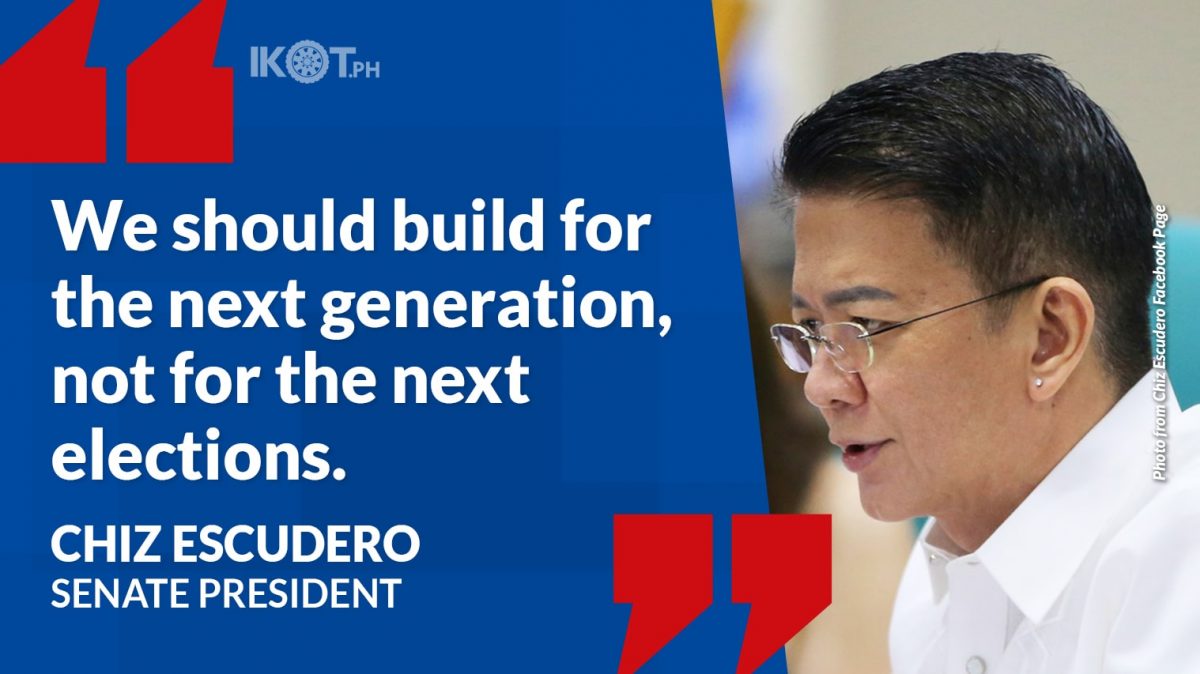Senate President Chiz Escudero expects to see intense scrutiny on the flood control programs of the government when the Senate begins its plenary debates on the proposed P6.352 trillion national budget.
With so many parts of the country devastated by the onslaught of Tropical Storm Kristine, Escudero is certain the flood control budget will be a hot topic when the Senate takes up the appropriations of agencies such as the Department of Public Works and Highways, the Department of the Interior and Local Government, the Department of Social Welfare and Development, and the Department of National Defense-Office of Civil Defense.
“Flooding is not a modern-day phenomenon. It has been with us long before the birth of the republic. Every administration has its own ‘Great Flood’ to contend with,” the Senate Chief said.
“We have geographical handicaps to begin with. Nasa typhoon alley tayo. Daanan tayo ng bagyo. Tapos we have a high annual rainfall–both a curse and a blessing. Maaring buenas kung tama lang, malas kung sumobra,” the veteran legislator added.
In this era of climate change, the seasoned lawmaker said, typhoons are getting “more frequent, fiercer and fickler than before. Even Mindanao has lost its status as typhoon free”.
“One reason is that human development has encroached on natural flood plains.”
“One reason is that human development has encroached on natural flood plains. No go, no build zones dapat mga ‘yan. But population pressure on housing has forced us to roll the dice on that kaya tinayuan ng mga bahayan,” he noted.
Forest denudation has also contributed to the problem and when the trees that intercept and absorb rain are gone and communities now stand in their place, Escudero said, “this is what we call a perfect storm.”
“Theoretically, rising seas and higher flood waters must lead to rising appropriations and a higher budget for climate adaptation, of which, I must emphasize, flood control is but one component. Kaya ang budget ng Pilipinas ay unique. Disaster is becoming a de facto macroeconomic assumption. That is a given in the world’s most calamity prone nation,” he noted.
In 2023, according to data from the Philippine Atmospheric, Geographical and Astronomical Services Administration, a total of 11 tropical cyclones entered the Philippine Area of Responsibility. The average amount of rainfall was pegged at 2,777.4 millimeters.
“Kahit sa fundamentals na naka-angkla ang budget, may tinatawag na budget sensitivity index. Kung tumaas ang inflation or bumaba ang piso, or tumaas ang GDP, may kaukulang impact on revenues and expenditures. Ganyan din ang mga kalamidad. It moves the needle on how much we spend more and collect less,” Escudero said.
Under the 2023 national budget, P291.2 billion out of the P1.46 trillion total infrastructure outlay or 19.86% went to flood control projects. This went up to P353 billion this year or 23.36% of the P1.5 trillion spending for infrastructure.
Bulk of the funding went to the DPWH at P282 billion and P351 billion for 2023 and 2024, respectively.
For 2025, the proposed budget for flood control under the DPWH amounts to P303 billion, representing close to 34% of its total appropriations.
“We will not only exact accountability but also make sure the 2025 budget will provide preventive measures to avoid a recurrence.”
“Moving forward, however, we will not only exact accountability but also make sure the 2025 budget will provide preventive measures to avoid a recurrence as well as adequate rehabilitation and response in case of a similar calamity in the future,” he said.
“Smart spending has a bias for durable projects, not adhocracy or band-aid solutions na seasonal ang paglatatag ng lunas. We should build for the next generation, not for the next elections,” Escudero added.
He gave credit to the administration of President Ferdinand Marcos Jr. for responding with higher budgets for flood mitigation.
“Ang tanong, sapat ba ang ito upang rumesponde sa nagbabagong panahon? Is the PBBM administration merely implementing a catch-up plan that will erase the collective neglect on flood management by previous administrations?” Escudero said.
“Disaster response should not depend on people’s resiliency alone, but also on government response. But disaster response is not the government’s duty alone, it is the responsibility of the whole nation. Pagdating ng baha, iisang bangka tayo,” he concluded.


